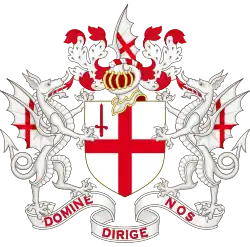Charles Peers
Sir Charles Peers | |
|---|---|
%252C_Lord_Mayor_of_London_(1715-1716)%252C_and_His_Daughter_Mary_(b.1710)_-_1645_-_Guildhall_Art_Gallery.jpg) Portrait of Sir Charles Peers | |
 | |
| In office 1715–1716 | |
| Monarch | George I |
| Preceded by | Sir William Humphreys |
| Succeeded by | Sir James Bateman |
| Sheriff of the City of London | |
| In office 1708–1709 | |
| Alderman of Tower Ward | |
| In office 1708–1737 | |
| Common Councilman for Aldgate Ward | |
| In office 1701–1708 | |
| Master of the Worshipful Company of Salters | |
| In office 1716–1717 | |
 | |
| In office 1714–1715 | |
| Succeeded by | Robert Child |
| Director of the Bank of England | |
| In office 1705–1707 | |
| In office 1708–1712 | |
| Personal details | |
| Born | 1661 London, England |
| Died | 1737 England |
| Spouse(s) | Sarah Bauds, Elizabeth Green, Lucy Beighton |
| Children | 8 |
| Occupation | Merchant, Politician |
Sir Charles Peers (1661 – 29 January 1737) was a British businessman who became the Chairman of the East India Company in 1714[1] and Lord Mayor of London in 1715.[2] He had previously served as one of the Sheriffs of the City of London in 1708–1709.[3][4]
Biography
Peers was born to Edmund Peers (d. 1681) and Mary Walden, in 1661, of the parish of the St. Katherine Creechurch, Aldgate ward, London.[5] Through his mother, he was a nephew of Sir Lionel Walden, who served as Mayor of Huntingdon. Peers was educated at St Paul’s School, London.[6]
Peers was an active merchant trading between Málaga, London, and other European ports, operating both on his own account and as an agent for other merchants in England.[7] In 1689 Peers married Sarah Baud, the niece of Lady Susanna Morden (née Brand), the wife of Sir John Morden, founder of Morden College.[8] Through this union, Peers expanded his commercial interests, reportedly receiving a quarter share in a East Indiaman, the 'Velez Merchant' as part of Sarah's dowry.[7]
Peers' trading accounts reveal voyages from Málaga to Amsterdam, Hamburg, Danzig, and transatlantic routes including Boston to Jamaica, with Bristol as his main English port. His trade involved commodities such as wine, sherry, fruit, oil, soap, nuts, indigo, hides, silk stockings, and clocks.[7]
He started his career as a salter (trader of salt) and also as the London partner of William Morley and Company of Málaga, merchants and importers. He later became Common Councilman for Aldgate Ward 1701–8, and Alderman of Tower Ward 1708–37.[9]
Peers served as Master of the Worshipful Company of Salters, one of the Great Twelve Livery Companies of the City of London in 1716-17.[10]
He was a Director of the Bank of England in 1705-07 and 1708–12, a Director of the New East India Company in 1701-05 and 1706–09 and a Director of the United East India Company in 1712-15. He was Chairman of the latter for 1714-15.[11]
He was knighted on 16 July 1707, by Queen Anne of Great Britain.[12] He served as a Sheriff of the City of London (1708–1709) and as Lord Mayor of London (1715–16), of which he was granted a coat of arms reflecting his civic prominence.[13]

See also
References
- ^ The_India_list_and_India_Office_list The India list and India Office list for ... - Great Britain. India Office - Google Books
- ^ Lord Mayors of London Archived 2010-02-09 at the UK Web Archive City of London website.
- ^ Noorthouck 1773, pp. 889–893
- ^ Reynolds, C. (2019). Surveyors of the Fabric of Westminster Abbey 1906-1973. Reports and Letters. Boydell & Brewer. p. 415. ISBN 978-1-78327-420-8.
- ^ Sir Charles Peers (1661 - 1737) Archived 2014-01-01 at the Wayback Machine Family tree.
- ^ St. Paul's School (London, England) (1884). Admission registers of St. Paul's school, from 1748 to 1876. Harvard University. London : G. Bell.
- ^ a b c "Bristol and the Atlantic Trade in the Eighteenth Century" (PDF). University of Bristol. 1982. p. 38. Retrieved 20 July 2025.
{{cite web}}: CS1 maint: url-status (link) - ^ Green, Thomas Frank (1916). Morden college, Blackheath. University of California Libraries. [London, Printed for the Committee by Eyre and Spottiswoode, limited.
- ^ "PEERS, Sir Charles (1661-1737): Administrative/Biographical history". London Metropolitan Archives: City of London, ref code: GB 0074 CLC/B/227-148.
- ^ Shipwrights, The Worshipful Company of. "Past Masters". The Salters' Company. Retrieved 19 July 2025.
- ^ "Chronological list of aldermen: 1701-1800". British History Online. Retrieved 4 January 2018.
- ^ City of London, St Olave's Church, Hart Street: Monographs. #39
- ^ "John Strype's Survey of London Online". www.dhi.ac.uk. Retrieved 20 July 2025.
- Noorthouck, John (1773). "Addenda: The Mayors and Sheriffs of London (to 1773)". A New History of London: Including Westminster and Southwark. pp. 889–893.
External links